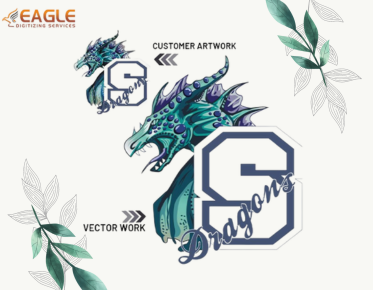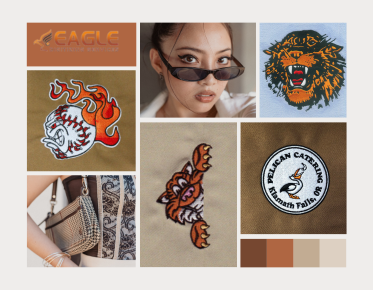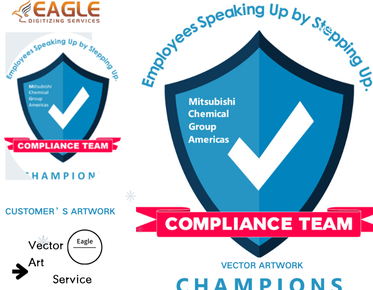How can Rotary Screen Printing Transform Your DIY Projects from Eagle Digitizing?
Rotary screen printing is a dynamic and efficient method of transferring intricate designs onto fabrics and other materials. This technique utilizes a rotating cylindrical screen, which allows for continuous and rapid printing. It's a favorite in the textile industry due to its ability to produce large volumes with high precision and vibrant colors. If this post spurred your interest and you want to find out more about vector artwork convsersion, please feel free to contact us.
A Brief History of Rotary Screen Printing
The origins of rotary screen printing trace back to the mid-20th century when advancements in textile manufacturing demanded faster and more efficient printing methods. Traditional flat-screen printing, while effective, couldn't keep up with industrial-scale production needs. Enter rotary screen printing, a game-changer that revolutionized the textile industry by combining the principles of screen printing with rotary motion, significantly boosting production speeds and quality.
Understanding the Basics
What is Rotary Screen Printing?
Rotary screen printing involves using a cylindrical screen that rotates as the substrate (usually fabric) passes underneath. The design is etched onto the screen, and as it rotates, ink is pushed through the mesh onto the fabric. This continuous process allows for seamless patterns and high-speed production.
How It Differs from Other Printing Methods
Unlike flat screen printing, which prints one section at a time, rotary screen printing is continuous, making it much faster and more suitable for large runs. It also offers superior registration for intricate designs compared to methods like direct-to-garment printing, which can be slower and less precise.
Why Choose Rotary Screen Printing?
Key Benefits and Advantages
Rotary screen printing boasts several advantages:
● Speed and Efficiency: Capable of printing thousands of yards per hour, it's ideal for mass production.
● Consistency: Ensures uniformity across long runs.
● Versatility: Suitable for a variety of fabrics and materials.
● Cost-Effective: Reduces labor costs and waste in large-scale production.
Common Applications and Industries
This method is predominantly used in the textile industry, especially for printing fabrics for clothing, home textiles, and upholstery. It's also used for printing wallpapers, labels, and non-woven materials.
Essential Equipment for Rotary Screen Printing
Rotary Printing Press: The Heart of the Process
The rotary printing press is a sophisticated machine designed to handle the cylindrical screens and facilitate continuous printing. Its precision and speed are crucial for high-quality output.
Screens and Cylinders
Screens, also known as cylinders, are made of durable mesh materials. They are coated with a photo-reactive emulsion and etched with the design. The choice of mesh count affects the ink deposit and the print's detail.
Inks and Dyes
Rotary screen printing uses a variety of inks and dyes, including water-based, plastisol, and reactive dyes. The choice depends on the substrate and the desired finish.
Squeegees and Blades
Squeegees and blades are used to push the ink through the screen onto the substrate. Their hardness and shape can affect the print quality and ink distribution.
Setting Up Your Printing Workspace
Organizing Your Printing Area
A well-organized workspace enhances efficiency. Arrange the printing press, screens, and drying racks in a logical sequence. Ensure adequate ventilation for drying and curing processes.
Essential Tools and Supplies
Stock your workspace with necessary tools like spatulas, screen cleaners, emulsion scoops, and protective gear. Keep inks and dyes stored properly to prevent contamination.
Safety Measures and Best Practices
Adhere to safety guidelines, including wearing gloves and masks when handling inks and chemicals. Ensure proper ventilation and follow proper disposal methods for waste materials.
Designing for Rotary Screen Printing
Creating Effective Print Designs
Designs should be bold and clear. Fine details might not transfer well, so simplicity often yields the best results.
Using Design Software
Software like Adobe Illustrator and CorelDRAW are ideal for creating designs. These programs allow for precise adjustments and scalability.
Preparing Your Artwork for Production
Convert your design into a high-contrast black-and-white image. This serves as the stencil for the screen. Ensure the file is in a format compatible with the screen exposure process.
Preparing the Screens
Coating with Emulsion
Apply a light-sensitive emulsion evenly on the screen. This layer will harden upon exposure to UV light, forming the stencil.
Exposing and Developing the Design
Expose the coated screen to UV light with your design placed on top. The light hardens the emulsion except where it is blocked by the pattern. Wash out the unexposed areas to reveal the stencil.
Cleaning and Reusing Screens
After printing, clean the screens thoroughly to remove ink and emulsion. Screens can be reclaimed and reused multiple times, making them cost-effective.
Setting Up the Rotary Printing Press
Aligning Screens and Substrates
Proper alignment is crucial to avoid misprints. Use registration marks to ensure each screen aligns correctly with the substrate.
Calibrating Pressure and Registration
Adjust the pressure to ensure the right amount of ink passes through the screen. Proper registration ensures each color and design element aligns perfectly.
The Printing Process Explained
Applying Inks and Dyes
Pour the ink into the screen and allow it to flow evenly. The rotating screen distributes the ink uniformly across the substrate.
Using the Squeegee Effectively
The squeegee pushes the ink through the screen onto the substrate. Consistent pressure and angle are key to achieving uniform prints.
Drying and Curing the Prints
Dry the prints using a conveyor dryer or heat press. Proper curing ensures the ink bonds well with the substrate, enhancing durability.
Troubleshooting Common Issues
Fixing Print Quality Problems
Blurry or uneven prints can result from incorrect pressure or misalignment. Regularly check and adjust the press settings.
Managing Ink Flow and Consistency
Ensure the ink is at the right viscosity. Too thick, and it won’t flow; too thin, and it might bleed.
Handling Screen Wear and Tear
Screens can wear out over time. Regularly inspect for damage and replace or repair screens as needed.
Advanced Techniques in Rotary Screen Printing
Multi-Color Printing Mastery
Print one color at a time, allowing each layer to dry before applying the next. Use precise registration marks for alignment.
Adding Special Effects and Finishes
Incorporate metallic inks, foils, or puff additives to create unique textures and finishes.
Printing on Various Materials
Adjust your technique based on the substrate. Different materials require specific inks and curing processes.
Maintaining Your Equipment
Cleaning and Caring for Screens
Clean screens immediately after use to prevent ink from hardening. Use appropriate cleaners and follow recommended procedures.
Regular Press Maintenance Tips
Regularly lubricate moving parts and check for wear. Keep the press clean to ensure smooth operation.
Storing Equipment for Longevity
Store screens upright in a dry, dust-free environment. Keep inks in airtight containers to prevent drying out.
Ensuring Consistent Quality
Quality Control Methods
Implement regular quality checks at each stage of the process. This helps catch issues early and maintain high standards.
Tips for Maintaining Print Consistency
Monitor ink levels and screen conditions. Regularly calibrate your press to ensure consistent output.
Eco-Friendly Practices in Rotary Screen Printing
Using Sustainable Inks and Materials
Opt for water-based or eco-friendly inks. They’re less harmful to the environment and safer to handle.
Minimizing Waste and Recycling
Reuse screens and recycle leftover materials. Implement efficient inventory management to reduce waste.
Energy-Efficient Printing Techniques
Use energy-efficient dryers and presses. Consider solar power or other renewable energy sources for your operations.
DIY Rotary Screen Printing
Setting Up a Home Printing Studio
A home studio requires basic equipment like a small rotary press, screens, and inks. Allocate a well-ventilated space for printing and drying.
Budget-friendly Equipment and Supplies
Start with affordable, entry-level equipment. DIY kits can provide a cost-effective introduction to rotary screen printing.
Fun DIY Projects to Get Started
Create custom t-shirts, posters, and home decor items. Experiment with different designs and materials to hone your skills.
Future Trends in Rotary Screen Printing
Emerging Technologies and Innovations
Advancements like automated presses and digital integration are pushing the boundaries of rotary screen printing.
Market Trends and Future Predictions
The demand for sustainable and customized products is driving growth in the rotary screen printing industry. Expect continued innovation in eco-friendly materials and processes.
Rotary screen printing is a versatile, efficient method suitable for various applications. Its ability to produce high-quality prints at scale makes it indispensable in the textile industry. Embrace the possibilities of rotary screen printing. Experiment with new techniques and materials to discover your unique creative style.
FAQs about Rotary Screen Printing
Q: What materials can be used in rotary screen printing?
A: Rotary screen printing works on various materials, including fabrics, paper, and non-woven materials.
Q: How do I maintain my rotary printing press?
A: Regular cleaning, lubrication, and inspection of parts are essential for maintaining your press.
Q: Can I print multi-color designs with rotary screen printing?
A: Yes, multi-color printing is possible with precise registration and careful alignment of screens.
Explore the fascinating world of rotary screen printing and unlock your creative potential with this versatile technique. Happy printing!



